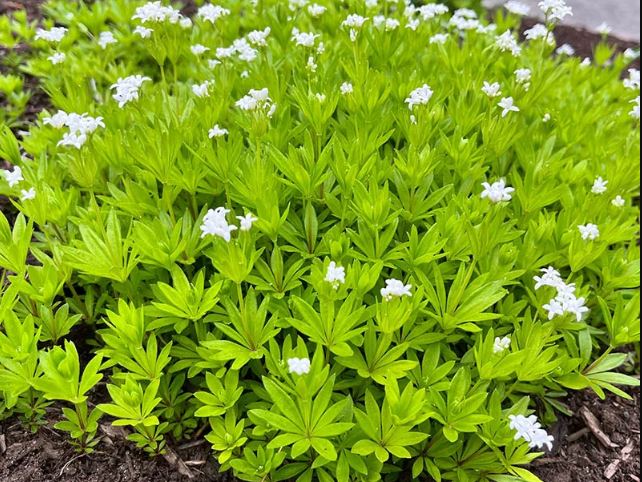
Galium odoratum, also known as Asperula odorata, the sweet woodruff or sweetscented bedstraw, is a flowering perennial plant in the family Rubiaceae, native to much of Europe from Spain and Ireland to Russia, as well as Western Siberia, Turkey, Iran, the Caucasus, China and Japan. It is also sparingly naturalised in scattered locations in the United States and Canada.
While considered a native and beneficial plant in its original range, in some North American regions where it has been introduced, it’s viewed as potentially invasive due to its ability to spread rapidly in suitable conditions.This plant go through growth cycles that include flowering in spring, fruiting, and then a period of dormancy during colder months.
Sweet Woodruff has a low-growing, spreading nature. Its leaves are bright green, whorled around slender stems, and each leaf is lance-shaped with a pronounced central vein. The plant produces small, star-like, white flowers in late spring that hover just above the foliage.
This plant grows to a height of about 10-12 inches (25-30 cm) and spreads to form a ground cover, thriving in the dappled shade of woodland settings. The plant feature sweet, hay-like scent, which intensifies when dried. This aroma comes from coumarin, a compound that also gives new-mown hay its characteristic smell.
This plant spreads via rhizomes underground and can also set seed, which can lead to its natural expansion in suitable environments. While not overly aggressive, it can become more widespread over time if not managed.
During medieval times, Sweet Woodruff was strewn on floors, used in bedding, or added to sachets to freshen the air. In folklore, Sweet Woodruff was associated with good fortune and was used in wedding bouquets for good luck and to ward off evil spirits.
Uses
- Its delicate appearance makes it an excellent choice for woodland gardens, underplanting beneath trees, or as a border in shaded areas where other plants might not thrive.
- Traditionally, dried Sweet Woodruff was used to scent linens and rooms. It’s also an ingredient in May wine, a traditional European punch, where its sweet scent complements fruity flavors.
- Historically used in herbal medicine for its mild diuretic, astringent, and antispasmodic properties. It was often used to ease digestive issues, promote sleep, and as a tonic.
- Works well with other shade-loving plants like hostas, ferns, primroses, or under larger shrubs and trees where it can form a lush ground cover.
Cultivation and Care
- Prefers well-drained, humus-rich soil. It doesn’t tolerate waterlogged conditions well but appreciates moisture-retentive soil.
- Does best in partial to full shade. Direct sunlight can scorch the leaves.
- Regular watering during dry spells is beneficial, especially when establishing the plant. Once settled, it’s relatively drought-tolerant but performs best with consistent moisture.
- It’s low-maintenance; however, cutting back after flowering can encourage a second bloom and keep the plant from becoming too leggy. Division every few years can rejuvenate the plant if it starts looking sparse.
Considerations
- Can be propagated by division in spring or fall, or from seed, though it might take longer to establish from seeds.
- While not considered invasive in most regions, Sweet Woodruff can spread via rhizomes and seeds. In ideal conditions, it can become quite vigorous but is generally manageable with some control.
- Generally, it’s quite hardy against pests and diseases, though it can occasionally suffer from powdery mildew if air circulation is poor.